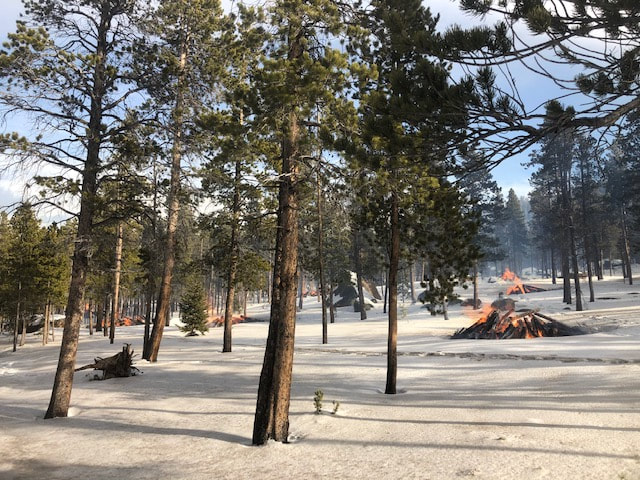Rocky Mountain National Park announces a pilot reservation system using timed entry in 202411/9/2023 November 9, 2023
Rocky Mountain National Park (RMNP) will implement a pilot reservation system using timed entry in 2024, beginning May 24. The pilot is similar to that used in 2023 with two types of reservations available. One permit will be for the Bear Lake Road Corridor, which includes the entire corridor, as well as access to the rest of the park. This reservation period will be from 5 a.m. to 6 p.m. The second permit will be for the “rest of the park,” excluding the Bear Lake Road corridor. This “rest of park” reservation period will be from 9 a.m. to 2 p.m. Permits issued using the reservation system will allow park visitors to enter the park within two-hour windows of availability, with no set time for departure. The reservation system will apply to all areas of the park. The only cost associated with booking a reservation is a $2 recreation.gov processing fee. The Bear Lake Road Corridor timed entry reservation system will continue through Sunday, Oct. 20. However, the rest of the park reservation system will end on Tuesday, Oct. 15. Reservations to enter the park will be available through www.recreation.gov following the below schedule.
Modifications from the 2023 pilot system to the 2024 pilot system include making the night before reservations available at 7 p.m. MT through recreation.gov, rather than 5 p.m. These are expected to run out quickly and visitors are encouraged to plan ahead when possible. RMNP is currently accepting public feedback on its Environmental Assessment for the park’s long-range day use visitor access plan. More details are available on the park website and comments can be submitted through Dec. 14, 2023. This plan is needed to provide day use visitor access in a way that protects resources while creating opportunities for high-quality visitor experiences in the long term. RMNP is one of the most visited national parks. The park experienced a 44 percent increase in visitation from 2012 to 2019. In 2021, the park received 4.4 million visits. Even with a vehicle reservation timed entry system in place, the park received some of the highest visitation in its history. Between 2016 and 2023, the park piloted several day-use visitor management strategies to address crowding, congestion, and impacts on park resources. These pilots have demonstrated this strategy is effective at easing congestion impacts and improved the visitor experience in the park. The park also asked the public for their participation in envisioning the future of day use visitor access at Rocky Mountain National Park during the summer of 2021 and the winter of 2022-2023.
0 Comments
By Estee Rivera Murdock, Executive Director at the Rocky Mountain Conservancy
Not all heroes wear capes, as they say—some wear neon yellow jackets with arrowhead patches. Rocky Mountain National Park (RMNP) hosts more than four million visitors a year, and with that high level of visitation, typically has the third highest number of major search and rescue (SAR) events in the National Park Service (NPS) each year. The Rocky Mountain Conservancy is proud to support the law enforcement and other rangers and staff on Rocky’s SAR teams. In 2021, the Conservancy purchased a new custom-outfitted AWD SAR van for the park’s east side, and this year purchased a SAR utility vehicle for the park’s west side. The Conservancy also funds some of the extensive recurring training necessary to safely evacuate patients from impossible places as well as to replenish supplies and equipment. To take care of the people who put themselves at risk looking after the rest of us, the Conservancy underwrites the cost of first responder-focused mental health services that are available 24/7. “Behind every RMNP SAR or emergency response you might read about or follow on the scanner are a lot of people,” says Jay Shields, Rocky’s Chief Ranger for Law Enforcement and Emergency Services. “We put our park rangers and staff in extraordinary circumstances that involve intense physical, emotional, and psychological trauma. With professionalism and compassion, Rocky’s SAR teams and first responders rise to challenges most people can only imagine.” It's easy to oversimplify who gets in trouble in the backcountry. It’s not just visitors unfamiliar with “know before you go” principles. Trouble can find anyone. Just ask former two-time Olympian and Mayor of Estes Park Wendy Koenig who required a SAR evacuation for a leg injury. Loose rocks and tree roots on a trail don’t care if you’re a first-time hiker or a world class mountaineer. In July 2022, an experienced hiker from the Midwest suffered a severe injury in a remote area of the park. Rocky’s SAR team responded, and, working with a flight medic and a Colorado Army National Guard helicopter crew, airlifted the patient off the mountain for transfer by Northern Colorado Med Evac air ambulance to advanced medical care. The hiker was in a coma for more than a month and continues his journey of rehabilitation—but he survived. This summer, the hiker’s family wrote a heartfelt thank you letter to the SAR team and donated to the Conservancy’s Search & Rescue Fund. They wrote, “How can we ever repay you and the rest of the wonderful folks who played a part in this story? Take heart in knowing that you made a difference in many people’s lives because of what you and others did that day.” Behind the scenes, people might be surprised at how few professionals are responsible for working these major incidents, especially when a relatively straightforward patient carry-out might take up to 30 people. “Our bench of rescue personnel is limited,” Shields continues. “SAR qualification requires extensive training and a huge level of commitment. SAR team members are drawn from all divisions in the park, but the majority are our climbing staff as well as our law enforcement rangers. Our professional law enforcement staff also are trained as SAR, Fire, and Emergency Medical Service professionals; no other group in our agency is tasked with this level of emergency service to our public.” My family and I spend a lot of time exploring Rocky’s backcountry, and knowing the park has a SAR capability with such passionate and capable members gives me a lot of peace of mind. If so inclined, consider donating to our SAR fund at www.RMConservancy.org/SAR or to any professional or volunteer SAR organizations in your local community. Even more importantly, the next time you encounter a law enforcement ranger or other SAR team member, shower them with gratitude and appreciation for their sacrifices. We owe them more than we can say. Rocky Mountain National Park Announces Winter Pile Burning Operations on Both Sides of Park11/1/2023 November 1, 2023
Fire managers from Rocky Mountain National Park plan to take advantage of any upcoming wet or winter weather conditions to burn piles of slash generated from several fuels reduction projects and hazard tree removals. Slash from these projects has been cut and piled by park fire crews and contractors over the last two years and are now dry enough to burn. Burning could start in early November and continue through April as weather permits. Pile burning operations will only begin when conditions allow. The piles are in a variety of locations including areas near the boundary of the park with Allenspark, near Lily Lake, west of Deer Mountain, near Moraine Park Campground, in the Willow Park area off Old Fall River Road and on the west side of the park along US Highway 34/Trail Ridge Road near the Green Mountain and Coyote Valley Trailheads. When fighting the East Troublesome Fire in 2020, firefighters were able to take advantage of previous and existing prescribed fire and hazardous fuels treatment areas that provided a buffer between the fire and the town of Estes Park. Prior hazard fuels projects aided considerably in stopping the fire from jumping Bear Lake Road and Trail Ridge Road. Years of hazardous fuels reduction projects and bark beetle tree removal on the west side were instrumental in the successful burnout operations around the town of Grand Lake and helped minimize structure loss in the main park housing area. The fuels reduction projects are designed to reduce significant accumulations of forest fuels that can generate extreme or problematic fire behavior adjacent to wildland urban interface. By reducing the potential fire behavior, the wildland fire risk to firefighters and the public is significantly reduced. However, these projects are not designed as a stand-alone defense against wildfires, nor are they guaranteed to hold a wildfire in the worst of conditions. Please do your part and complete wildfire mitigation on your property. To learn more about wildfire mitigation around your home visit www.firewise.org Safety factors, weather conditions, air quality and other environmental regulations are continually monitored as a part of any fire management operation. Prescribed fire smoke may affect your health. For more information see https://www.colorado.gov/pacific/cdphe/wood-smoke-and-health. For questions about this project or information about Rocky Mountain National Park please call the park’s Information Office at (970) 586-1206 or visit www.nps.gov/romo |
RMNP UpdatesPress Releases from Rocky Mountain National Park and the Rocky Mountain Conservancy.
Archives
September 2025
|
© Copyright 2025 Barefoot Publications, All Rights Reserved

